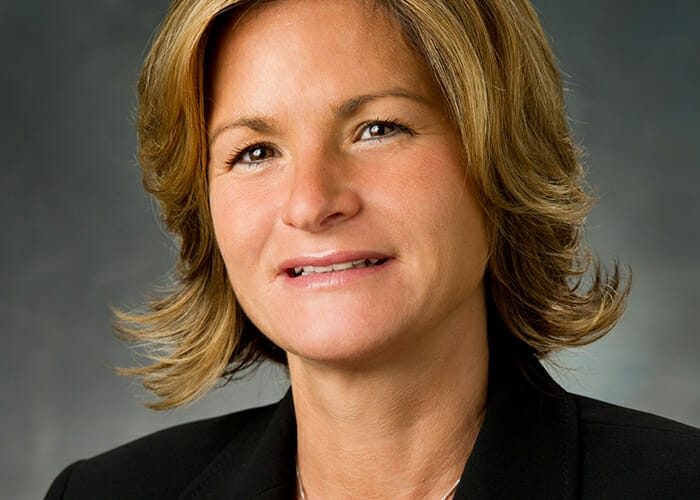When Robin Diamonte became chief investment officer of the pension fund for US technology giant United Technologies Corporation, (UTC), in 2004, 85 per cent of the portfolio was in growth assets and 15 per cent was in fixed income, with no hedging element at all.
UTC, which develops and manufactures high-tech products, particularly for the aerospace industry, has a global workforce of some 196,000 and boasts a defined benefit plan of $24 billion. Through the course of the past 10 years, Diamonte has introduced diversity and risk management to the defined benefit portfolio with sophisticated and complex liability driven investment (LDI), risk parity and portable alpha strategies with a keen focus on the fund’s liabilities.
“When I took the job we set about integrating the pension fund strategy closely with the corporate strategy. The size of the pension fund is large, versus the market cap of the company, and if I could reduce volatility in the pension fund, it was clear it would be good for the company. I’ve been in the business for a long time. In the 1990s most pension fund chief investment officers had no idea what a liability even was: they just focused on investment returns.
“2003 was a major shock, then came 2008. I’d say some have adapted but some haven’t,” she says in an interview from the fund’s Connecticut headquarters.
Now the portfolio is divided between growth assets (65 per cent) and hedging assets (35 per cent). The hedging element is shaped around a liability driven investment strategy that consists of a portfolio of long corporate bonds tracking a customised Merrill Lynch index, shaped to suit UTC’s specific pension liabilities. It currently accounts for around 40 per cent of the fund’s interest rate risk.
“Our LDI strategy is focused on building a hedging portfolio and de-risking over time. It’s moving slowly because of low interest rates, but we are hedging a great deal more than we ever did.”
The remaining 65 per cent of the portfolio is in growth assets, divided between global equity, private investments – that include private equity and distressed debt allocations – real estate, risk parity and structured equity, or so-called portable alpha.
The 14 per cent allocation to portable alpha, grown from an initial 5 per cent but unlikely to get much bigger, is designed to combine alpha over time with an underlying beta that contributes to the fund’s liability driven investment strategy.
By simultaneously hedging the fund’s liabilities and achieving an excess return – the portable alpha produced 3 per cent alpha last year – Diamonte is adamant the strategy “allows us to have our cake and eat it.”
It gives “some juice” in an arching de-risking trajectory and steady increase in the funded ratio.
“We are targeting a funded ratio of over 100 per cent,” she says. The plan was 83 per cent funded in 2004 when she joined and ended last year at 88 per cent funded, but has spiked above that during her tenure.
The portable alpha allocation was originally set up so the beta portion came from long bond futures, but this was changed to a global equity futures exposure.
“We have the underlying beta in futures and cash with hedge fund managers. The hedge fund managers are all market neutral and low volatility; they are alpha generators, but because they are market neutral they haven’t blown up,” she says, using a term often associated with hedge fund failures.
‘Jumped’ on urban, small and luxurious real estate
“What we are trying to achieve is an uncorrelated alpha stream that has low volatility. We only expect between 2-3 per cent from the alpha. We never took away from our equity allocation and put it into hedge funds,” she says in reference to the guiding principles, and expectation, behind the allocation.
In the past year, UTC’s allocations to private equity and real estate performed the best.
“Our private equity does well when the equity market does well, but has less volatility and higher returns. Private equity managers can take a longer-term view, have more flexibility and control, and don’t suffer from as much regulation,” she explains. The fund’s 6 per cent allocation to real estate returned 16 per cent last year.
“The main reason real estate has done so well is because it has come off a very low base,” she says.
The fund seeks high-quality, low-risk investments, with assets including 35 properties owned outright. Diamonte has found a particularly strong investment theme co-developing urban, small and luxurious complexes characterised by common spaces, security and gyms for residents.
“We jumped on this and it’s done very well. One of our properties is up 36 per cent, another is up 80 per cent.”
In contrast, risk parity hasn’t fared as well.
“The risk parity allocation underperformed the total fund in 2014 and 2015,” says Diamonte. “The commodity component, added to help the portfolio in rising inflation markets, has been a drag on performance. However the portfolio has done well since its inception in 2005. It has provided diversification and has performed as expected in the various environments.”
Be nimble and be quick
The majority of the fund is in active allocations bar a few exceptions.
“We still have passive allocations but for the most part it’s active.”
Diamonte only has an eight-strong internal team and all assets are externally managed.
She says it’s a challenge finding managers for active strategies that add value over time, but welcomes a trend among managers to develop pension solution departments. As well as an increasing appetite among managers to be more of a partner with pension funds rather than just selling products.
“Hedge fund and private equity firms are more willing to listen and negotiate on fees. They are definitely more buyer-friendly”, she adds.
The fund uses some 40 managers, excluding the private equity allocation, and another 40-odd in private equity.
“That number has come down. We increasingly use the same manager to manage different portfolios. We spend a lot of time understanding our managers and seeking how to combine their different styles.” She says that because United Technologies is a large portfolio it can negotiate better fees, which come in at around 30-40 basis points.
But Diamonte doesn’t believe insourcing would offer the fund any benefits.
“If you are all in passive strategies and if you are immunised, it makes sense to be internal. But we want to be nimble and we are de-risking overtime. If we were to manage our assets in house, it would require research, trading facilities and compliance to meet regulation. We’d build up, for example, an emerging markets desk, but then we’d be getting rid of emerging markets as we de-risk, so it wouldn’t make sense. As it is, we can hire and fire and be nimble if our managers are losing their competitive edge,” she says in a nod to the ability to change and adapt that lie at the heart of her strategy.
“My background was in electrical engineering. I was the only female back then but I didn’t really notice. I think women do think about things differently. We are more willing to change our minds if something isn’t working.”



